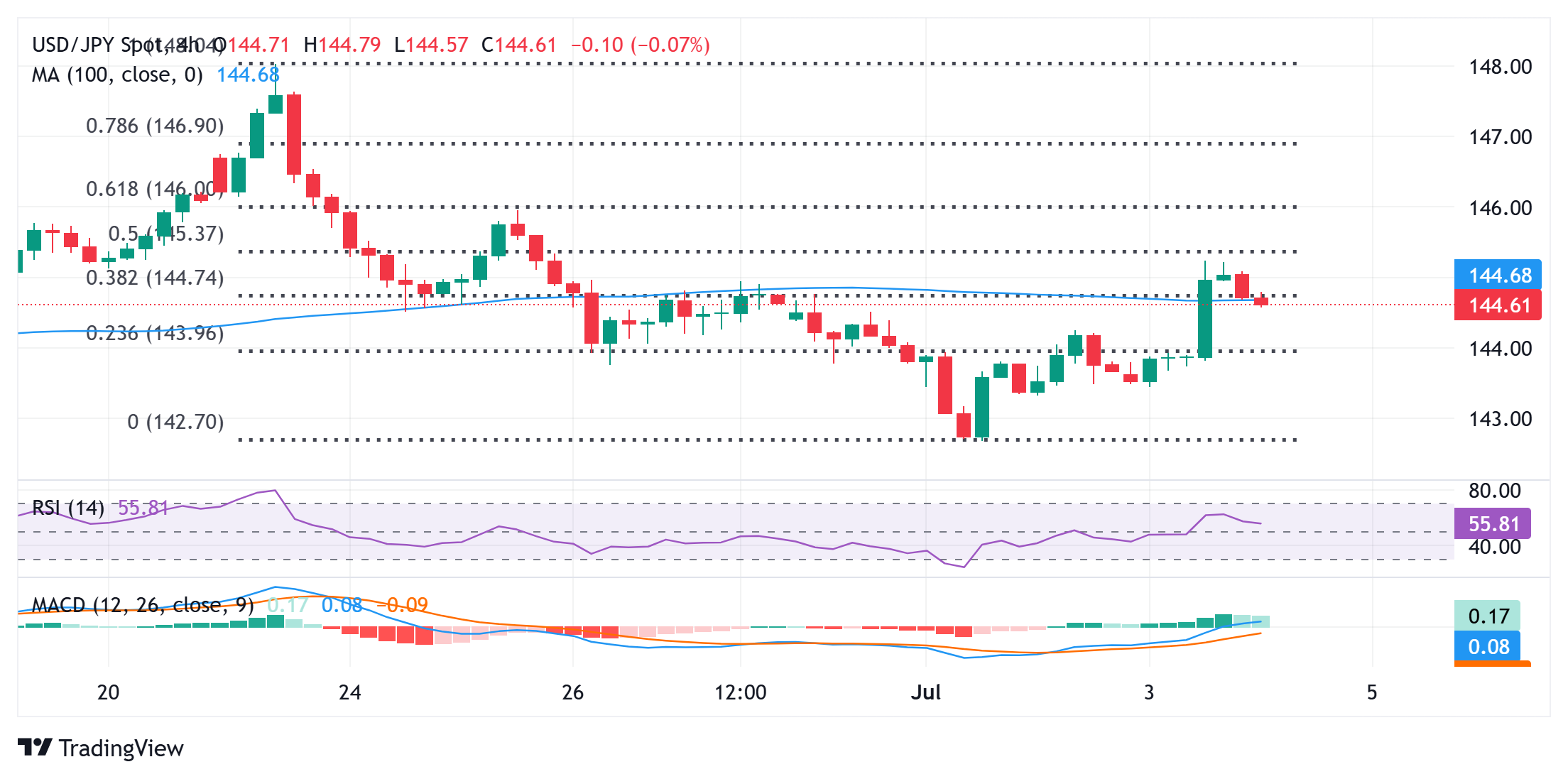Japanese Yen sticks to strong Household Spending data-inspired gains

- The Japanese Yen attracts buyers as the upbeat data reaffirms BoJ rate hike bets.
- US fiscal concerns undermine the USD and further weigh on the USD/JPY pair.
- The divergent BoJ-Fed expectations back the case for further losses for the pair.
The Japanese Yen (JPY) scales higher during the Asian session on Friday following the release of strong domestic Household Spending data, which keeps the door open for more interest rate hikes by the Bank of Japan (BoJ). This, along with a modest US Dollar (USD) downtick, drags the USD/JPY pair away from a one-week high, around the 145.20-145.25 region touched in reaction to the upbeat US monthly jobs data on Thursday.
Meanwhile, investors remain worried that global trade tensions triggered by US President Donald Trump's tariff policies could complicate the BoJ's efforts to normalise monetary policy. Apart from this, the prevalent risk-on environment might cap gains for the safe-haven JPY and help limit losses for the USD/JPY pair. Traders might also refrain from placing aggressive directional bets amid the expected thin liquidity on the back of a US holiday.
Japanese Yen strengthens in reaction to stronger Household Spending data
- The US Bureau of Labor Statistics (BLS) reported on Thursday that the economy added 147,000 new jobs in June compared to the previous month's upwardly revised reading of 144,000 and the 110,000 expected. Moreover, the Unemployment Rate edged lower to 4.1% from 4.2% in May and pointed to a still resilient US labor market.
- The topline beat gives the Federal Reserve space to stick to its wait-and-see approach amid the uncertainty stemming from US President Donald Trump's trade policies. This, in turn, pushed the US Dollar (USD) and the USD/JPY pair to a fresh weekly high, though the momentum lacked strong follow-through or bullish conviction.
- Additional details revealed that annual wage inflation growth, as measured by the change in the Average Hourly Earnings, retreated to 3.7% from 3.8% in May. This was short of the analysts' estimate of a 3.9% rise. This, along with concerns about the worsening US fiscal condition, contributes to capping the upside for the buck.
- US President Donald Trump’s tax-cut and spending bill cleared its final hurdle in Congress on Thursday, averting the near-term prospect of a US government default. The legislation would explode the federal deficit as it is estimated to add $3.4 trillion to the nation’s debt over the next decade. This would make America’s long-term debt problems even worse and hold back the USD bulls from placing aggressive bets, capping the USD/JPY pair.
- Meanwhile, the Japanese Yen attracts some buying during the Asian session on Friday after a government report showed that Household Spending surpassed even the most optimistic estimates and rose 4.7% in May from a year earlier. The upbeat data reignites speculation of near-term interest rate hikes by the Bank of Japan.
- In contrast, traders still see a greater chance that the Fed will resume its rate-cutting cycle in September and lower borrowing costs by at least 50 basis points by the end of this year. This contributes to the USD/JPY pair's slide, though trade uncertainties might hold back traders from placing aggressive directional bets.
USD/JPY technical setup warrants caution for bulls; 144.00 mark holds the key

The overnight breakout through the 144.65-144.70 confluence – comprising the 100-period Simple Moving Average (SMA) on the 4-hour chart and the 38.2% Fibonacci retracement level of the June-July downfall – was seen as a key trigger for the USD/JPY bulls. However, failure near the 145.25 supply zone, which nears the 50% retracement level, and the subsequent pullback warrant some caution before positioning for any meaningful upside.
Meanwhile, any further slide is likely to find some support near the 144.20 horizontal zone ahead of the 144.00 round figure, or the 23.6% Fibo. retracement level. A convincing break below the latter might shift the bias back in favor of bearish traders and drag the USD/JPY pair to the 143.45 intermediate support en route to the 143.00 mark. The downward trajectory could extend further towards the 142.70-142.65 region, or a one-month low touched on Tuesday.
On the flip side, the 145.00 psychological mark might now act as an immediate hurdle ahead of the 145.25-145.30 zone. Some follow-through buying should allow the USD/JPY pair to test the 61.8% Fibo. retracement level and conquer the 146.00 round figure.
Economic Indicator
Overall Household Spending (YoY)
The Overall Household Spending released by the Ministry of Internal Affairs and Communications is an indicator that measures the total expenditure by households. The level of spending can be used as an indicator of consumer optimism. It is also considered as a measure of economic growth. A high reading is positive (or Bullish) for the JPY, while a low reading is negative (or bearish).
Last release: Thu Jul 03, 2025 23:30
Frequency: Monthly
Actual: 4.7%
Consensus: 1.2%
Previous: -0.1%
Source: Ministry of Economy, Trade and Industry of Japan







